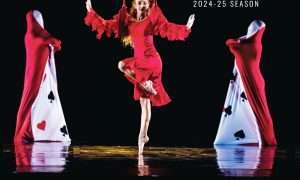Inside the Artist’s Studio:
Four Corners, Robert Langham III
By Derrick White
The Anasazi were Ancestral Puebloans, an ancient Native American culture existing about two thousand years ago in what is now the Four Corners region of the United States (southwestern corner of Colorado, southeastern Utah, northeastern Arizona, and northwestern New Mexico). They are thought to be the ancestors of later tribes like the Hopi. Religiously, they were polytheistic and had faith in many gods relating to nature (i.e. a rain god, a sun god, as well as good old mother earth). The Anasazi held many of their religious rituals and political meetings in dark or dimly lit underground rooms called kivas. There was a kachina belief. The central theme being an existence of life in all the objects of the universe and everything having a spirit or lifeblood, and that mankind must cooperate with these forces or fail to survive. This is not unlike the ancient Greek belief of daemon creative spirit guides. The Romans later changed the name to genius in the context of someone artistic, who was not thought to be a really intelligent person but rather had found favor with a disembodied essence who would assist with delivering ideas and the execution of the work.
“I’m beset by ideas, swarmed by ideas, hived, hounded. They pop into my head. They arrive on a piece of trash blown down the street or seep from the edge of a shadow. They pursue me in dreams and arrive during conversations, meals, baths, silence, sex, at 72 mph on the highway, they appear. They lurk in trees, closets, boxes, corners, elevators, concrete, dirt, space and in the pocket-lint of my jeans. Seductive or repellent. Arrowing, cascading, collapsing like lost children and salesmen. They fall from the sky, spurt from a shower head in places public and private. They keep no schedule, crowding in without appointment or announcement, elbowing, jostling through the press, caring neither for consciousness nor condition. Oblivious to budget or schedule, 10,000 angelic demons, seeking me, seeking me always,” states local artist Robert Langham III.
Robert comes across as a shrewd and relaxed guy. I can easily imagine him in New Mexico having a deep philosophical conversation or maybe just hanging out and having a beer with Terry Allen (an outlaw, autonomous artist working in a diverse range of media including music, sculpture, painting, and video and who, it is worth mentioning, has a song titled Four Corners). Robert Langham is a fine art and commercial photographer and some of his works are mystic, while others are ghostly and reminiscent of cyanotypes, a photographic process generating a cyan-blue image. His subject matter seems to twirl and move in an unworldly, spiritual way: the blue being there to calm the viewer down, to help quiet the mind while the eyes look and the intellect wonders. Some works involve multiples: pieces of items both organic and man-made, stacked, melting, bundled, bound, attached, or whirled in a tornadic force. Other photographs have animals presented not in their natural habitats but instead in an encounter with mankind.
Robert achieves these shuffling still-life photographs not with a computer but by using long-established traditional film, camera, and darkroom techniques. He uses big roll film and sheet film in large cameras. He composes visual dances with multiple exposures and controlled trickeries. Robert Langham shows viewers how ability, artistry, and patience are essential to composing filmic captivations. When one views his images, it is easy to believe they too have some sort of kachina – a sense of life in these inanimate objects happening to shift and cavort with an unseen life-force and reminding us of all the connections in our world and objects; or the manipulation of nature, which were at one time human concepts and thoughts, asking how are we to collaborate and persist together.
Langham earned a degree in photography and art from Sam Houston State University. He has taught at both TJC and Sam Houston. What started Robert down the path of becoming an artist was that, in his words, “I was seduced and then betrayed by an older woman,” but art has brought purpose and understanding to his life. He explains, “It is the search for truth, isn’t it? Art becomes the refining of one’s self, the piercing of veils, and the shedding of layers. Art is the way you walk in the world. You soak yourself in your subject matter and then an idea appears, a new idea. Maybe it is a new stupid idea, but it is new. You somehow failure it into the world and all of a sudden, like snapping your fingers, something new exists. It is a miracle. When you look around yourself in the world almost everything you see is not most importantly a physical thing, it was someone’s idea first. I am a little tender and adoring of new human ideas and the sheer adventure and exhilaration of the process. It’s fun.” He adds, “Anything worth doing is worth doing badly, at first. If you can’t embrace, anticipate, celebrate, and enjoy failure you are going to have a rough time with art.”
Robert Langham III gets inspirations from his daily life and all he encounters. He likes the early work of Man Ray (American visual artist and photographer contributing to both the Dada and Surrealist movements of the early 20th century). Robert advises, “I look at other media besides photography. Never look too much at your own media. If they are good, they drag you off to their lair and eat you. If they are bad, it is a waste of time. Look at something else.” He continues, “My best advice is to find your subject matter and look at it. I look at paintings but mostly enjoy ones not made from photographs. I like paintings from the artists’ imaginations.” Robert visited the recent Claude Monet exhibition at the Kimball Museum of Art in Fort Worth twice and says he got photographic ideas from the show. He states he is crazy about the Anasazi and also likes Inuit and Pompeian art.
I like this idea of the Anasazi of all things and people being connected, and the reverence they had for nature, objects, and our earth. Robert’s photographs of pirouetting feathers remind me of their philosophy and I wish we could all cooperate more with all things, all people, and good old mother earth… and perhaps survive. But sometimes I worry the four corners reference actually comes from Revelation 7:1, “I saw four angels standing at the four corners of the earth, holding back the four winds of the earth to prevent any wind from blowing on the land or on the sea or on any tree …four angels given the power to harm the land.”



















